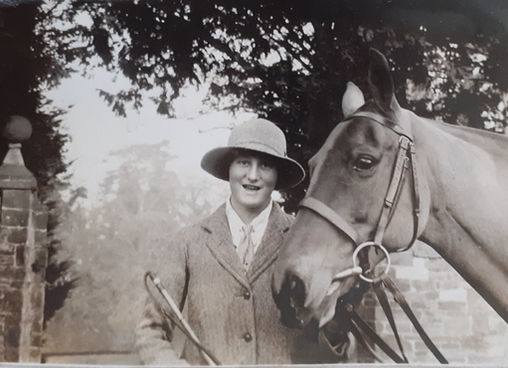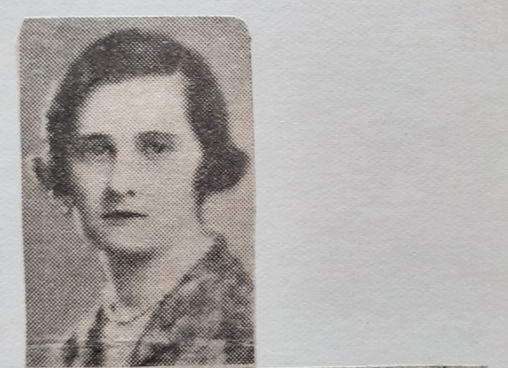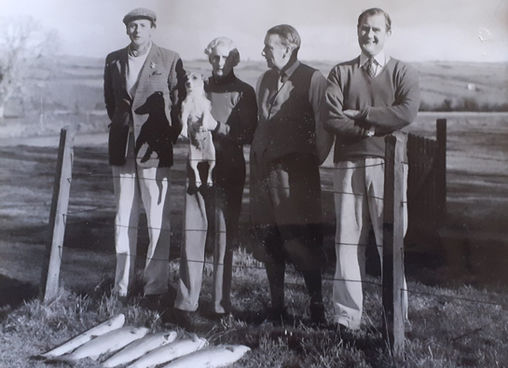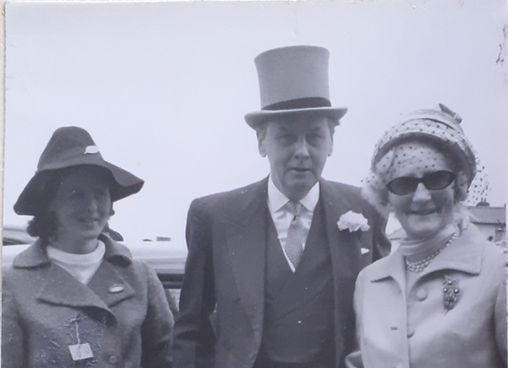The Life & Times of Miss Monica Sheriffe
Monica Sheriffe, known to the younger members of her family and the villagers of Goadby Marwood as ‘Miss Mon’, was born at Wyndham Lodge in Melton Mowbray on February 3rd, 1903. In 1920, Colonel Richard Dalgleish purchased Wyndham and gave it as a gift to the town to honour those who had fallen during the Great War. It became known as Melton & District War Memorial Hospital. It was closed in 2002, and today the building has been converted into luxury apartments.
Monica’s father, Capt. Robert Thomas Oliver Sheriffe, was born in Thurmaston, Leicestershire in 1860, the son of Thomas Bowen Sheriffe and Madeline Elizabeth Massey. He graduated from Magdelene College, Cambridge, before joining the army and he served as 2nd Lieutenant with the Norfolk Artillery Militia, including a spell as Aide-De-Camp to the Governor of New South Wales. He served as Lieutenant with the Nottinghamshire (Sherwood Rangers) Yeomanry Cavalry, and later with the 3rd Battalion Imperial Yeomanry during the Boer War. Present at the actions at Spitzkop, Lindley and Rhenoster River he was promoted Captain on March 20th, 1901 and was awarded the Queen’s South Africa Medal 1899-1902, with three clasps - Cape Colony, Orange Free State and Transvaal.
Capt. Sheriffe’s father died when he was just four years old and his mother remarried, her second husband was Col. Heneage Charles Bagot-Chester, the couple had two sons together. The eldest of these, Greville Bagot-Chester, was killed in action during WW1. Captain Sheriffe also had two full sisters; the youngest, Madeline Harriet Sheriffe, married the famous actor/producer, Charles Henry Hawtry, regarded as Britain's leading comedy actor of his generation, the couple later divorced.
When in the UK, Capt. Sheriffe divided his time between the Massey family home, Henstead Hall in Suffolk, and London, and on January 1st, 1901, he married Muriel Vickers, who was 17 years his junior, at St. Mary’s Church, Bryanston Square in Marylebone.
Muriel Vickers, born in 1877 at Dykes Hall, Wadsley near Sheffield, was the daughter of Frederick Vickers and Anna Maria Durham. Frederick was the youngest son of Edward Vickers who, with his father-in-law, George Naylor, founded Vickers and Naylor Co. (later Vickers and Sons Ltd). Formed in 1828 in Sheffield as a steel foundry, the business went public in 1867 as Vickers, Sons & Company, and later merged with Armstrong-Whitworth to become Vickers-Armstrong. The company began life making steel castings, though gradually acquired more businesses, branching out into various sectors including the construction of armaments, warships, and military aircraft. The company is perhaps most famous for construction of the Spitfire fighter plane that played such an important role throughout the Second World War and in particular during The Battle of Britain.
Capt. Sheriffe and Muriel lived in a number of large rented houses in the first years of their marriage including Toddington Manor in Bedfordshire, The Old Hall in Asfordby and Wyndham Lodge in Melton Mowbray, before moving to Goadby Marwood Hall sometime before 1911. The property was owned by The Duke of Rutland but by 1920, The Duke of Rutland estate, like many others, was facing a severe cash-flow crisis. The Duke had rolled over debts incurred when Belvoir Castle was rebuilt at the beginning of the 19th Century and these, together with the sudden decline in agricultural income and higher taxation imposed after The Great War, forced the 8th Duke to sell large parts of his Leicestershire estates, including Goadby Hall. Capt. Sheriffe, purchased the property and the Sheriffe family remained at Goadby Hall throughout the 20th Century.
Monica and her older sister, Joan Madeline Sheriife, did not attend school, but were taught at home by a governess. Joan was born in October 1901 at Toddington Manor. On August 11th, 1925, at St. Mark’s Church, North Audley Street in London she married Edward ‘Toby’ Greenall (later Second Baron Daresbury) whose family had property nearby. Following their marriage, the couple lived at Melton Spinney near Scalford. Tragically, Joan was seriously injured in a hunting accident on 12th March 1926 whilst pregnant with her first child; she died three days later having never regained consciousness. Her memorial service and burial took place at Goadby on March 18th.
Capt. Sheriffe died just three years after his eldest daughter, on May 30th, 1929, and was buried at Goadby Marwood. His widow, Muriel, continued to live at Goadby Hall with her youngest daughter, Monica, until her death in November 1956.
The Sheriffe family had a great love of horses. Capt. Sheriffe, known as Bertie to his family and friends, was a regular judge at local point-to-point races, as well as being involved with the local hunts. Monica followed in the family tradition in the involvement of all things connected with horses, especially hunting. She was also a keen member of Melton Polo Club, which was founded in 1908, and in later years she formed a local women’s polo team, the first in the country.
Between the two World Wars, Melton Mowbray was the place to be for the ‘hunting set’. It was ideally placed to ride to hounds four or five days a week with the Quorn, Cottesmore and Belvoir Hunts all close by. Again, Monica led the way when, in the mid-1920s, she became one of the first women to stop hunting side-saddle choosing to ride astride instead. She is said the have described riding side-saddle thus: “Goodness it was hell! Riding a mile down a road nearly broke one’s back!”
To accommodate members of the hunting set, lodges sprung up all around Melton. The most famous of these was Craven Lodge on Burton Street, which was named after a previous owner, The Hon. W G Craven, who converted the house into a splendid hunting establishment. Later it was subdivided into apartments for letting to the hunting fraternity, but it had a revived heyday when, in 1923, it was enlarged to accommodate ‘The Craven Lodge Club’. The most prominent member of the club was the then Prince of Wales, later King Edward VIII. In his later memoirs as The Duke of Windsor, Edward said of Craven Lodge: “…the rooms were simple but comfortable and the stabling first class." Regarding the hunting, Edward described the going in the Vale of Belvoir as: “…marvellous - ideal country for the chase.”
In a 1950 article for Life Magazine Edward wrote: “In addition to providing ideal country, the hunts centring around Melton Mowbray formed a unique and cosmopolitan society intermixed with the local gentry who formed the sure base of any hunting community, a lively sampling of dashing figures - nobleman and noble women; wealthy people who had discovered the stable door was a quick if expensive short cut into society; a strong injection of Americans from the famed Eastern hunts; ladies whose pursuit of the fox was only a phase of an even more intense pursuit of romance; retired Admirals and Generals; cavalrymen and guardsmen … yeoman farmers in ‘rat catchers‘ whose land was often a dismal scene after the ‘field’ had galloped over their farms, smashing the fences and leaving the gates open for cattle to stray. In this vigorous untrammelled company, my horsemanship improved and my world widened. Fox hunting satisfied my innate desire to pit myself against others on equal terms.”
In addition to the accommodation, Craven Lodge had seven acres of grounds including squash courts - a sport that was becoming very popular. It also provided 62 loose boxes and six saddle rooms. In 1924, having decided that he required something more permanent in the area, Edward had a private flat built at Craven Lodge overlooking the stables. Once the Prince of Wales had established himself at Melton, his brothers, friends, and the rest of the ‘Mayfair Set’ followed. Over the winter months, most of Mayfair society could be found in the town.
Monica Sheriffe was part of this society and was a frequent visitor to Craven Lodge. Weekly dances were held, and regular dinners after which poker was usually played, with, in today’s terms, thousands of pounds being won and lost nightly. While socialising in Melton, it is said that the ‘Mayfair Set‘ thought nothing of heading back to London for an evening social event before returning to Melton by train the next morning in time to join the hunting.
Fancy dress parties were a favourite at Craven Lodge, especially those that involved dressing up in drag or in animal costumes. Drinking was common, and discreet - or occasionally not so discreet - love affairs often took place. The pace was set by The Prince; they were the ‘fast set‘, and their activities were often described as ‘racy‘ by the media of the day. It has been written that Monica was not only a leading sportswoman but also a leading party-goer and typically spent only one evening a fortnight at home during the hunting season. Following one fancy dress party, where attendees dressed as school children, a local newspaper wrote: “The ballroom was converted into a nursery and all the guests dressed as small children, and carried favourite toys. Lord Northland was a schoolgirl in a short red check frock and black curls. The Hon. Mrs Edward Greenall [Monica’s sister] and Miss Monica Sheriffe were schoolgirls in party frocks, socks and corkscrew curls."
It was near Melton - at Burrough Court - when The Prince was visiting his friends, Lord and Lady Furness in 1930, that he met his future wife, the American divorcee, Wallis Simpson. The couple are believed to have visited Monica’s home, Goadby Hall, on occasion.
Monica’s appearance has been described as ‘manly’ although she is also described by those who knew her as ‘always incredibly elegant’. She was a keen bridge player and is said to have always smoked a cigarette from the side of her mouth whilst playing the game. She also apparently had a taste for cigars. Monica made no secret of the fact that her relationship preferences were with women although she had many gentleman admirers.
Monica regularly frequented many of the country’s great houses including Blenheim Palace, Highclere Castle and Chatsworth House. In early September 1939, when the National Register was taken, Monica was recorded as a visitor at Lavington Park, a large mansion house in Sussex, owned by the Wallace family. The owner, Barbara Lutyens Wallace, known as ‘Barbie’ to her friends, was the eldest daughter of the well-known architect, Sir Edwin Landseer Lutyens; she married David Euan Wallace in 1920. Wallace served in Government in a number of roles including as Civil Lord of the Admiralty, Financial Secretary to the Treasury, and Minister of Transport. In 1939, parts of Lavington Park were being used as a maternity hospital, but later it became the Commando Headquarters for the duration of the Second World War. Many of the plans for D‐Day were formulated at the mansion.
Monica was a keen motorist and during the war years she drove lorries for the ATS (Auxiliary Territorial Service). When not at home in Goadby, Monica spent her time in London at her flat, 12 Arlington Street, in the heart of St. James’s, and it is most likely during her time in London that she met the mysterious and exotic Elvira Chaudoir with whom she was to have a long and intimate relationship.
Elvira Josefina Concepcion de la Fuente, was born in Paris in 1911, the daughter of a Peruvian diplomat. She grew up in France where she received an expensive education courtesy of her wealthy father. In 1934, at the age of 23, Elvira married Belgian stockbroker, Jean Maximilien Hyacinthe Chaudoir, but she soon found that married life didn’t suit her. After a number of unsatisfying affairs, she ran away to Cannes with her best friend, Romy Gilbey, where the pair spent their time socialising and gambling. Following the German invasion of France Elvira fled to England. Here she spent much of her time gambling, and often found herself short of funds. She complained that because she was Peruvian, she could not find interesting paid work. Her complaints were overheard by a serving RAF officer and her name was passed around until it reached Lieutenant Colonel Claude Edward Marjoribanks Dansey, the assistant chief of MI6. As the daughter of a Peruvian diplomat based in Vichy France, Elvira had a perfect excuse for travelling between the two countries and Dansey persuaded her to work for the British Secret Service. On a trip to France in 1942, Elvira was approached by French collaborators and recruited into the German Intelligence Service. Following her return to London, she was debriefed by MI6 and passed to MI5 to be employed as a double agent.
MI5 had some concerns about Elvira’s reliability, in part because of her known lesbian relationships. Previously top-secret papers, now published by the National Archives, show that her phone, and those of her close associates, including Monica, were bugged, but Elvira turned out to be an invaluable addition to the Secret Service becoming one of the most successful double agents of the war. It is not known for certain whether or not Monica knew that Elvira was a spy, but according to her MI5 file, Elvira told her handler “…if anything happens to me - let Monica Sheriffe know."
Monica and Elvira were frequent visitors to Highclere Castle in Berkshire, the home of Lord and Lady Carnarvon. The summaries of Elvira’s correspondence with her German handlers, held by the National Archives, regularly cite Lord Carnarvon as a source of information. Today, Highclere Castle is famous as the location for the popular TV series, Downton Abbey.
Another close friend of the couple, who was a regularly quoted source in Elvira’s letters to the Germans, was The Honourable Bridget Hore-Ruthven who was married to George Howard, 11th Earl of Carlisle. At the beginning of the Second World War, Lady Carlisle was a Senior Controller of the Auxiliary Territorial Service, and was then promoted to become the Director of the Women's Auxiliary Corps in India (the Indian counterpart of the Auxiliary Territorial Service) and of the Women's Royal Indian Naval Service.
Elvira, under the codename ‘Bronx’, was instrumental in the British Secret Service deception known as ‘Operation Fortitude’ that was mounted in 1944 to persuade Hitler that the D-Day landings would take place around Calais, miles away from the Normandy Coast. On May 27th, on the instruction of her handlers, Elvira sent a coded telegram informing the Germans that the invasion would take place in The Bay of Biscay in one week’s time. Elvira’s message is credited with ensuring that the entire 11th Panzer Division remained in the southwest of France to defend against an attack that never came.
After the war, Churchill described Operation Fortitude thus: “Tangle within tangle, plot and counter-plot, ruse and treachery, cross and double-cross, true agent, false agent, double agent, gold and steel, the bomb, the dagger and the firing party, were interwoven in many a texture so intricate as to be incredible, and yet true.”
When peace was declared, Elvira retired to the South of France where she lived until her death in December 1995. Monica kept a treasured photograph of Elvira in throughout her long life, and the beautiful portrait still graces the same room in Goadby Hall today. Following the war, Monica continued to spend much of her time in London. She was a keen bridge player and could be found at the exclusive Crockford’s Club in Mayfair most evenings. She regularly won when those around her were losing and she attributed this to remaining sober when others did not. She drank sparingly, typically just one glass of sherry during the evening.
On the death of her mother in 1956, Monica inherited Goadby Hall and estate and she lived in the village for the remainder of her life. Monica’s greatest passion was her horses. She remained a keen huntswoman, regularly riding with the local Belvoir Hunt, and she also owned a number of racehorses, trained by her good friend, Jeremy Tree. One of these was ‘Sharpo’, who became the Champion British Thoroughbred sprinter for 1982. He won several high-profile races including the July Cup at Newmarket and the Prix de l' Abbaye de Longchamp in Paris, amassing winnings of over £230,000 during his career. Another successful thoroughbred racehorse owned by Monica was ‘Only For Life’ who, in 1963, won the 2000 Guineas at Newmarket and the King Edward VII Stakes at Royal Ascot.
Monica Sheriffe died at the age of 96 on March 11th, 1999, at home in Goadby Marwood. Her cremation service took place in Grantham and was followed by a thanksgiving service at St. Denys’s Parish Church in Goadby. It coincided with the first day of the Cheltenham race meeting and sadly many of her horse-racing friends could not attend. The Duke and Duchess of Devonshire, Lord and Lady Manton, and Lady Sarah McCorquodale (sister to Diana, Princess of Wales) were among those attending, and The Duke of Devonshire, who first met Monica at Cheltenham, gave a stirring address.
In 2016, The Duke of Devonshire, who is very well-known and highly regarded in the world of horseracing, named one of his home-bred youngsters, Monica Sheriff, and the filly, who is trained by William Haggas, has won a number of races since entering the scene. A fitting tribute to a remarkable woman, and one that Monica herself would no doubt appreciate.

Goadby Hall, Monica's home from a very young age, until
her death in 1999 at the age of 96.

Monica Sheriffe c. late 1910s.

Monica's parents, Capt. Bertie Sheriffe and
Muriel Vickers, c. early 1920s.

Joan Sheriffe and Edward 'Toby' Greenall on their wedding day in August 1925.

Melton Ladies Polo Team photographed after beating Hurlingham in July 1924. L to R: Lexie Wilson, Monica, and sisters Betty and Sandra Crawford.

Monica (right) with her friend, Peggy Bagot-Chester, at
Melton Show in 1927. Monica was one of the first ladies to choose to ride astride.
%2C%20Duke%20of%20York%2C%20Clare%20Tennant.jpg)
Monica (left) photographed out hunting with the Duke of York (later George VI) and Lady Clare Tennyson.

Monica (bottom row second from left) with a group at a fancy dress party, Craven Lodge, Feb 1923.

Monica with her good friend 'Porchey' (Henry George Alfred Marius Victor Francis Herbert, 6th Earl of Carnarvon) at Highclere Castle 1931.

The photograph of Elvira Chaudoir that Monica kept. The message at the bottom reads:
To darling Monica, Elvira.

Elvira Chaudoir with William 'Billy' Luke, case officer at MI5.
![Sharpo with jockey Pat Eddery [2].JPG](https://static.wixstatic.com/media/bc525f_1111ea4e563545a0b9167c0b2d6f90f2~mv2.jpg/v1/fill/w_341,h_252,al_c,q_80,usm_0.66_1.00_0.01,enc_avif,quality_auto/Sharpo%20with%20jockey%20Pat%20Eddery%20%5B2%5D_JPG.jpg)
'Sharpo' painted with his jockey, Pat Eddery.

'Only for Life' painted with his jockey, Jimmy Lindley.
From the late 1910s through to the early 1930s, Monica kept a series of scrap books in which she collected photographs and newspaper clippings of the events in her life. A selection from these appears in the gallery below, reproduced with the kind permission of Monica's goddaughter, Vicky Westropp. For a larger image and description click on the central image.
Monica continued to collect photos and newspaper clippings throughout the latter half of the 20th Century up until her death in 1999 at the remarkable age of 96.
A selection appears in the gallery below.




































![Sharpo Paris 1982 [2].jpg](https://static.wixstatic.com/media/bc525f_91fa5213226e48a78fb13177536b9b88~mv2.jpg/v1/fill/w_508,h_368,fp_0.54_0.31,q_90,enc_avif,quality_auto/bc525f_91fa5213226e48a78fb13177536b9b88~mv2.jpg)





